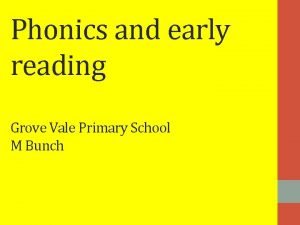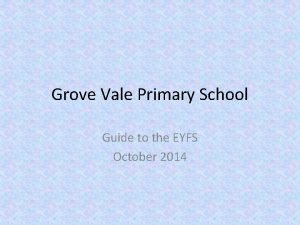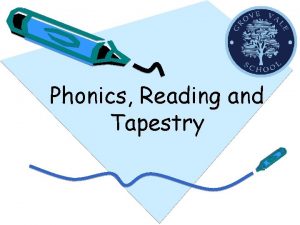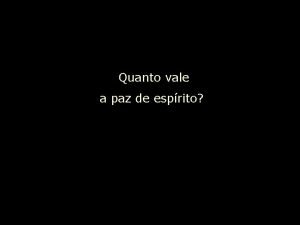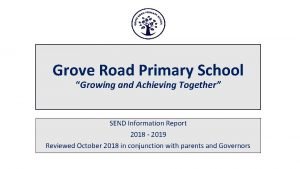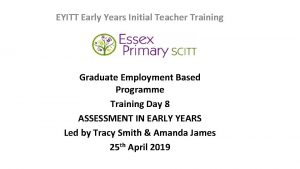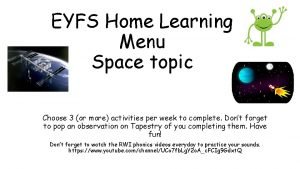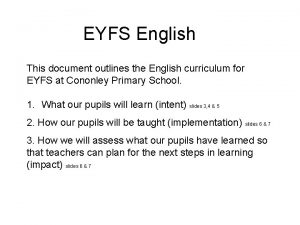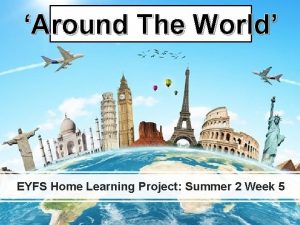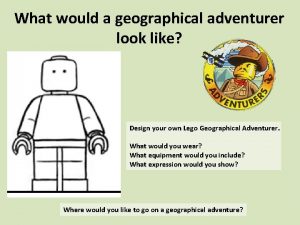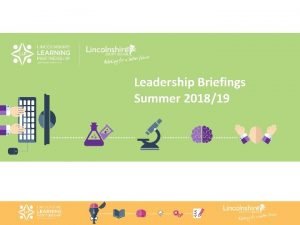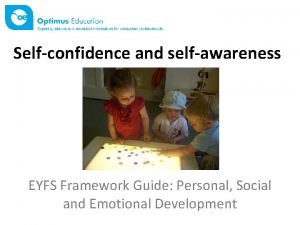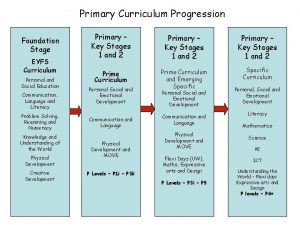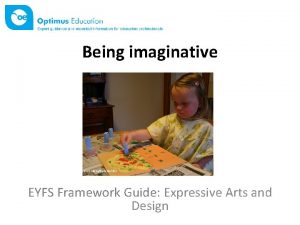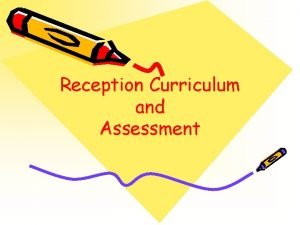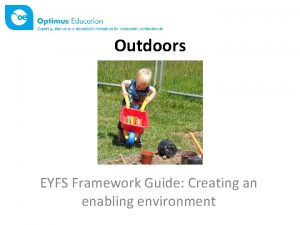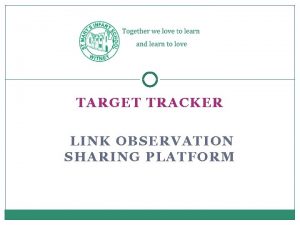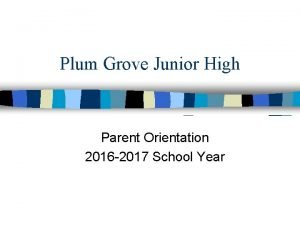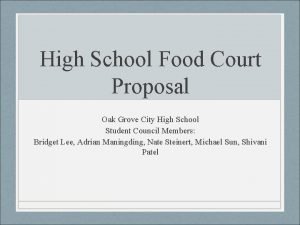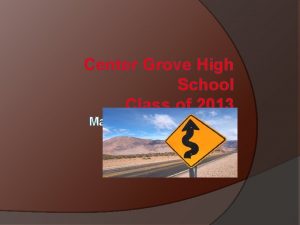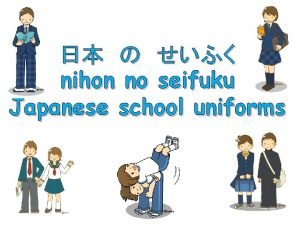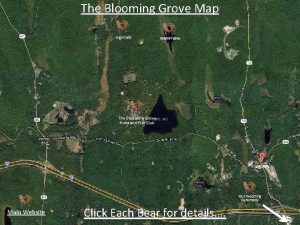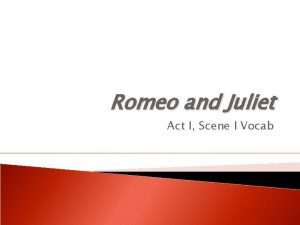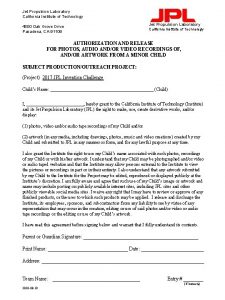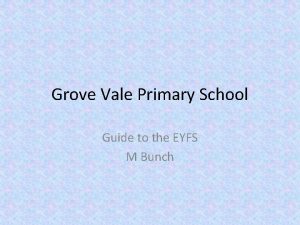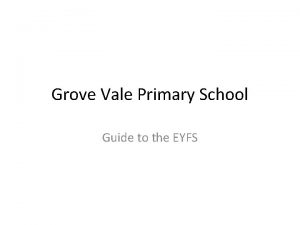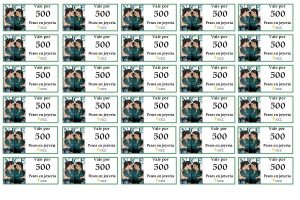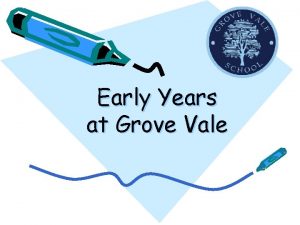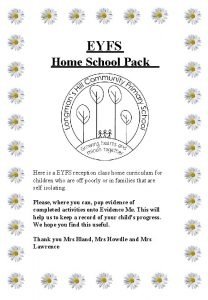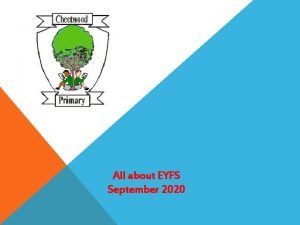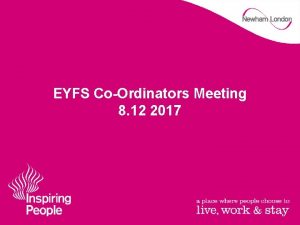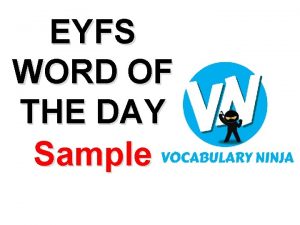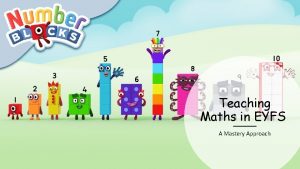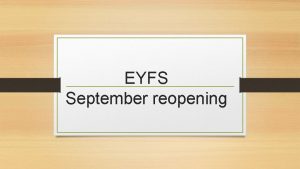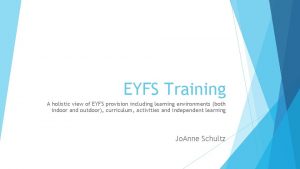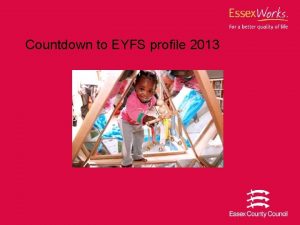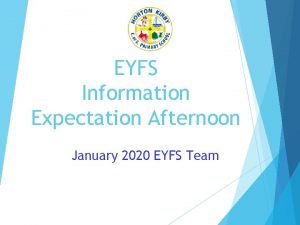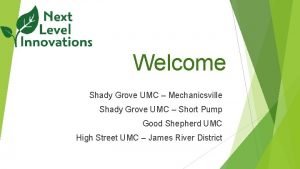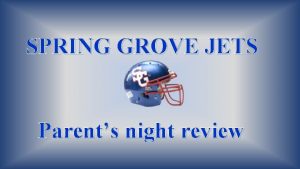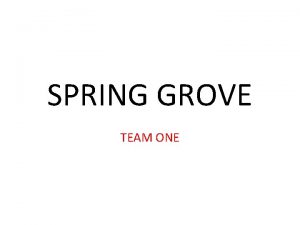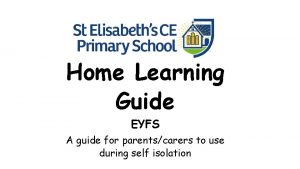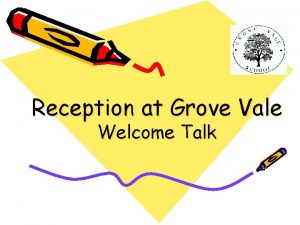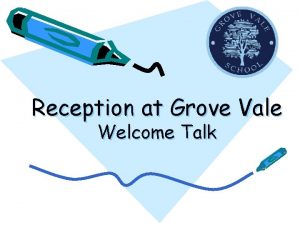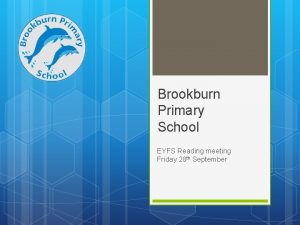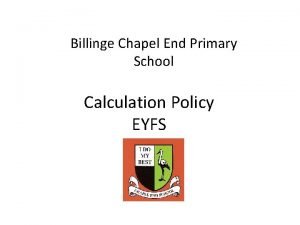Grove Vale Primary School Guide to the EYFS




























- Slides: 28

Grove Vale Primary School Guide to the EYFS

What is the Early Years Foundation Stage? • The Early Years Foundation Stage (EYFS) is the stage of education for children from birth to the end of the Reception Year. • It is based on the recognition that children learn best through play and active learning.

The EYFS has 4 themes

The 7 areas of learning

Typical day in Reception Autumn Term - Morning • Registration – your child will learn to find their own name and register them selves as here (a member of staff does oversee this!). • Teacher Time – to begin with we all collect together to discuss the day, the ‘things to do’ across the 3 areas (Sunshine room, Rainbow room and outdoors) and the things that the children are interested in. As the term progresses and the children have settled in this time changes to Jolly Jobs. Children will be completing 5 tasks over the week. These will include reading, writing and fine motor activities. They could also include showing children activities they can choose to do later on in the day. These ‘jobs’ may be done as a whole class or in groups depending on the activity

Autumn Term – A typical day. • Child – Initiated Time – Children will then choose activities from across the 3 areas (classrooms and outside) that they are interested in. They have access to the following – sand water, reading, role play, construction, small world, music, writing and mark making, maths, workshop (painting, collage, creative), snack, messy area, PE and bikes. The provision in these areas changes over time to reflect their interests and development. Other areas will be introduced at different times, again to reflect interest and development. During this time children will have snack time for milk and fruit – water is available all day. At this time teaching staff will be working in the 3 areas with the children on the things they are interested in. This is the time when we will be teaching children skills from the Early Learning Goals. At the end of this time children will then have Tidy Up Time! • During the morning session children will come back together with their class for Phonics and English teaching sessions

Autumn Term – A typical day. Autumn Term – Afternoon • Registration and Story • Teacher time- maths. In the second half term children begin Magical maths. Like jolly jobs children complete 5 tasks over the week, this time with a maths focus. They may work in a focus group with a teacher or independently, depending on the task. • Child – Initiated Time – Children will choose activities from across the 3 areas (classrooms and outside) that they are interested in - just like the morning session. At this time teaching staff will be working in the 3 areas with the children on the things they are interested in. They will also be making observations about the skills the children are using during their play. At the end of this time children will then have Tidy Up Time! • Show and Tell – everyone gets together to share things that have happened over the day. It is also a time to celebrate good work, behaviour and achievements before getting ready to go home.

Learning Through play Children are active learners Tell me and I'll forget. Show me and I'll remember. Let me do and I'll understand.

Communication and language

1. Speaking and listening 2. Understanding 3. Listening Listens attentively in different situations Follow instructions Answer 'how' and 'why' questions Express themselves effectively Encourage your child to listen carefully Ask you child questions Make your child answer in sentences Give your child instructions to follow involving several ideas or actions

By the end of reception… Children listen attentively in a range of situations. They listen to stories, accurately anticipating key events and respond to what they hear with relevant comments, questions or actions. They give their attention to what others say and respond appropriately, while engaged in another activity. Children follow instructions involving several ideas or actions. They answer ‘how’ and ‘why’ questions about their experiences and in response to stories or events. Children express themselves effectively, showing awareness of listeners’ needs. They use past, present and future forms accurately when talking about events that have happened or are to happen in the future. They develop their own narratives and explanations by connecting ideas or events.

Moving and handling Health and self-care Moves using large and small scale movements; running, jumping, climbing Move confidently and safely negotiates space Handle tools and equipment effectively including pencils for writing Healthy lifestyle Take a trip to the park so your child can run, jump and climb Feeling messy! Make some playdough! Encourage your child to hold scissors correctly - snip and cut paper Take a pot of water and a paintbrush outside so your child an 'paint' the pavement, fence or shed Encourage your child to use a pencil correctly - colour, trace over line

Gross Motor Fine motor Ways of moving Stands on 1 foot Catch a large ball Jumps off an object Negotiates space Travels around, under, over and through equipment • Pushing, patting throwing, catching and kicking an object • Uses 1 -handed tools • Draws lines and circles • Use anti-clockwise movements and retrace vertical lines • Makes snips in paper • Holds a pencil (thumb and 2 fingers moving to a tripod grasp) • can copy and form some letters • Has a dominant hand • • • Outdoor play PE/swimming Fine motor activities

By the end of reception… Children show good control and co ordination in large & small movements. They move confidently in a range of ways, safely negotiating space. They handle equipment and tools effectively, including pencils for writing. Children know the importance for good health of physical exercise, and a healthy diet, and talk about ways to keep healthy and safe. They manage their own basic hygiene and personal needs successfully, including dressing & going to the toilet independently.

Making relationships Managing feelings and behaviour Self confidence and S…. Develop their confidence. Talk about how they and others are feeling. Talk about their own and others behaviour and it's consequences. Know some behaviour is Unacceptable. Work as part of a group following the rules. Play co-operatively taking turns with others. Show sensitivity to others' needs and feelings. Form positive relationship with peers and adults. Play games to encourage sharing and taking turns. Praise your child when they try something new. Talk about how things make both you and your child feel. When your child does something they shouldn't have, encourage them to think about what they did and why it was wrong.

By the end of reception… Children play co-operatively, taking turns with others. They take account of one another’s ideas about how to organise their activity. They show sensitivity to others’ needs and feelings, and form positive relationships with adults and other children. Children are confident to try new activities, and say why they like some activities more than others. They are confident to speak in a familiar group, will talk about their ideas, and will choose the resources they need for their chosen activities. They say when they do or don’t need help. Children talk about how they and others show feelings, talk about their own and others’ behaviour, and its consequences, and know that some behaviour is unacceptable. They work as part of a group or class, and understand follow the rules. They adjust their behaviour to different situations, and take changes of routine in their stride.

Reading Writing • Uses phonic knowledge to sound out simple words • Read common irregular words 'tricky words' • Demonstrates an understanding of what they have read • Reads and understands simple sentences • Uses phonic knowledge to write words • Write some 'tricky words' • Write simple sentences • • Encourage your child to sound out words when reading. Play games eg lotto when learning key words. Read with your child. Encourage your child to talk about what they have read - re -tell the story in their own words. Ask your child questions about what they have read. Praise your child for 'having a go' and using their phonic knowledge to spell words. Encourage your child to 'write' eg shopping lists, cards, party lists.

By the end of reception Children read and understand simple sentences. They use phonic knowledge to decode regular words and read them aloud accurately. They also read some common irregular words. They demonstrate understanding when talking with others about what they have read. Children use their phonic knowledge to write words in ways which match their spoken sounds. They also write some irregular common words. They write simple sentences which can be read by themselves and others. Some words are spelt correctly and others are phonetically plausible.

Mathematics

Numbers Shape, space and measure • • • Recognises numerals Counts reliably Say what is 1 more and 1 less than a number Counts up to 10 objects Counts out up to 10 objects Beginning to understand the concept of altogether. Using numbers in their play. Recreates and continues a pattern Knows names of 2 D and 3 D shapes Uses language: heavier/lighter; full/empty; longer/shorter Knows days of the week Beginning to understand use the language of time Number spotting Counting out loud (forwards and backwards) Singing number rhymes Playing board games e. g. snakes and ladders

By the end of reception… Children count reliably with numbers from one to 20, place them in order and say which number is one more or one less than a given number. Using quantities and objects, they add and subtract two single-digit numbers and count on or back to find the answer. They solve problems, including doubling, halving and sharing. Children use everyday language to talk about size, weight, capacity, position, distance, time and money to compare quantities and objects and to solve problems. They recognise, create and describe patterns. They explore characteristics of everyday objects and shapes and use mathematical language to describe them.

Understanding the world

People and communities Technology The World Explores the world around them eg places, objects, materials and living things. Can recognise a range of technology used in schools and homes Develops their awareness of their own and other cultures Talks about past and present events in their own other family members lives Talk to your child about your family, culture, religion, where you live. Talk about what you can see, hear, smell, taste and touch. Ask your child what buttons they think you should press and why when using electrical equipment. Look for similarities and differences when out walking.

By the end of reception… Children talk about past and present events in their own lives and in the lives of family members. They know that other children don’t always enjoy the same things, and are sensitive to this. They know about similarities and differences between themselves and others, and among families, communities and traditions. Children know about similarities and differences in relation to places, objects, materials and living things. They talk about the features of their own immediate environment and how environments might vary from one another. They make observations of animals and plants and explain why some things occur, and talk about changes. Children recognise that a range of technology is used in places such as homes and schools. They select and use technology for particular purposes.

Expressive arts and design

Exploring and using media and materials. Being imaginative. Safely uses and explores a variety of materials, tools and techniques Sing songs and participates in musical and dance activities - exploring ways of changing them Uses what they have learnt about media and materials in an original way, thinking about uses and purposes. Represents their own ideas. Pretends and role plays things they have seen and experienced. Play role play games with your child, play teachers, shop keepers, be happy to be a passenger on a train. Use junk materials to make models big or small scale- you'll be surprised what your child will turn it into. Listen to and talk about sounds, make different sounds, quiet, loud etc. Keep your old clothes, shoes, hats, gloves to make into an exciting box of dressing up clothes.

By the end of reception… Children sing songs, make music and dance, and experiment with ways of changing them. They safely use and explore a variety of materials, tools and techniques, experimenting with colour, design, texture, form and function. Children use what they have learnt about media and materials in original ways, thinking about uses and purposes. They represent their own ideas, thoughts and feelings through design and technology, art, music, dance, role play and stories.

If you have any questions about your child’s development or progress please do not hesitate to speak to a member of staff.
 Grove vale primary school
Grove vale primary school Grove vale primary school
Grove vale primary school Grove vale library
Grove vale library Quanto vale a paz quanto vale o sossego
Quanto vale a paz quanto vale o sossego Grove road primary
Grove road primary Eyfs principles
Eyfs principles Eyfs space activities
Eyfs space activities Eyfs english curriculum
Eyfs english curriculum Around the world eyfs
Around the world eyfs Eyfs geography
Eyfs geography Eyfs profile data 2018
Eyfs profile data 2018 Self confidence and self awareness eyfs
Self confidence and self awareness eyfs Eyfs curriculum progression
Eyfs curriculum progression Mark making reception
Mark making reception Eyfs moodle hampshire
Eyfs moodle hampshire Being imaginative eyfs
Being imaginative eyfs What is eyfs
What is eyfs Enabling environments eyfs
Enabling environments eyfs Trackerlink
Trackerlink Plum grove junior high
Plum grove junior high Holly grove middle school
Holly grove middle school Food court project
Food court project Center grove high school
Center grove high school Pghs sports
Pghs sports Japanese elementary uniform
Japanese elementary uniform Beaver lake hunt club
Beaver lake hunt club Romeo and juliet act 1 scene 2 vocabulary
Romeo and juliet act 1 scene 2 vocabulary Kelvin grove university
Kelvin grove university 4800 oak grove drive pasadena
4800 oak grove drive pasadena
